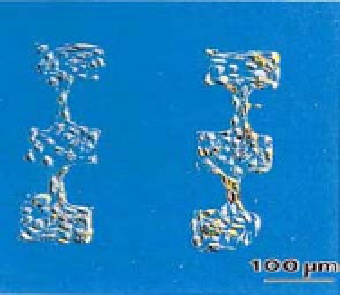Biomedical Engineering Reference
In-Depth Information
N
-terminus [42]. Because of the unique sequence of DAR16-IV and EAK12,
their side chain charges balance the helical dipole moment, therefore favoring
helical structure formation. However, they also have alternating hydrophilic
and hydrophobic residues as well as ionic self-complementarity, which have
been previously found to form stable
-sheets. Thus, the behavior of these
Type II molecules is likely to be more complex and dynamic than other
stable
β
-sheet peptides. Additional molecules with such dipoles have been de-
signed and studied, and the results confirmed the initial findings. Others have
also reported similar findings that proteins and peptides can undergo self-
assembly and disassembly or change their conformations depending on the
environmental influence, such as its location, pH change, and temperature, or
crystal lattice packing [43-45].
β
2.4
Peptide Ink
“Peptide inks”, undergo self-assembly on the surface rather than with them-
selves. They form monolayers on surfaces for a specific cell pattern formation
or to interact with other molecules. These oligopeptides have three distinct
features. The first feature is the terminal segment of ligands that incorporate
a variety of functional groups for recognition by other molecules or cells. The
second feature is the central linker where a variable spacer is not only used
to allow freedom of interaction at a specified distance away from the surface
but also controls the flexibility or rigidity. The third feature is the surface an-
Fig. 2
Peptide ink. This type of peptide has three distinct segments: a functional segment
where it interacts with other proteins and cells; a linker segment that is either flexible or
stiff and sets the distance from the surface, and an anchor for covalent attachment to the
surface. These peptides can be used as ink for an inkjet printer to directly print on a sur-
face, instantly creating any arbitrary pattern, as shown here. Bovine aortic endothelial
cells were confined to the patterns of squares connected with linear tracks. The patterns
were made with an oxygen gas treated PDMS stamp to increase the surface hydrophilicity
to facilitate EG6SH wetting

